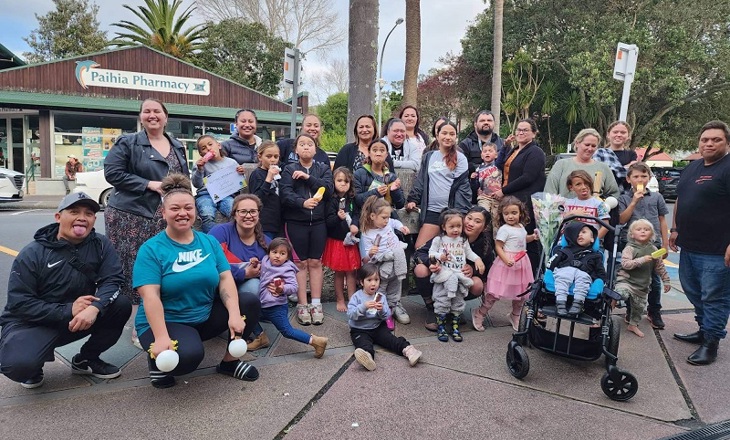Tākaro Tahi connecting whānau through play and Te Reo Māori
Tākaro Tahi connecting whānau through play and Te Reo Māori

Whaea Clara Aperahama (standing back left) and whānau from Tākaro Tahi
A tākaro Māori kaupapa (Māori play initiative) in Kaikohekohe in the Far North is helping whānau learn te reo Māori and connect with each other through play with an initiative called ‘Tākaro Tahi’.
Clara Aperahama Kopa (Ngāi Tūpoto, Te Rarawa, Ngāpuhi) believes tākaro (play) is a wonderful way to learn. She first created Tākaro Tahi in 2017 to help parents of tamariki in kura kaupapa (Māori-medium education) connect with te reo Māori in the home in a gentle and non-threatening way, that is, through play.
“I recognised that for many whānau, tamariki were learning te reo Māori at kura and parents were going to night classes, but there was no shared knowledge or space where whānau and their tamariki could connect,” she says.
“Play is the work of tamariki, we all know that. Many teachers of second languages use play to accelerate learning, whether it’s through role play, active play, games, repetitive play, waiata (song) or playing with equipment. You can teach anything through play.”
Whaea Clara saw Tākaro Tahi not only as a kaupapa to help whānau learn te reo Māori, but as a way for them to connect and spend time playing together.
“Because play is the focus, not the reo, no one feels they are on the back foot,” says Whaea Clara.
“For parents or grandparents, being able to come down to the level of their tamariki or mokopuna and connect with things that excite them – and us as well – allows intergenerational language acquisition to flow freely and naturally. Kia Māori te tuku. (Let it be Māori).”
“While we had our traditional tākaro Māori, poi, tī rākau (stick games), tititōrea (other stick games), i haere ki te eke maunga (climbing mountains), and we went to the marae, to the moana (sea), the urupa (cemeteries), and the wāhi tapu (sacred places), when you go home you can’t take the maunga with you, you can’t take the marae (traditional meeting house). We wanted to be able to offer whānau not only a safe space, but rauemi (resources) that they could take with them to allow play to happen anywhere,” says Whaea Clara.
So, with the help of Tū Manawa funding through Whaiao Sport Northland, the kura was able to hire a space to house the kaupapa and provide whānau with play packs. The packs include a blend of taonga tuku iho (treasures handed down), contemporary toys, and kete kōrero (language information cards) with positive phrases and kīwaha (idioms), to help tamariki to continue to play in te reo Māori at home.
Part of the Tākaro Tahi magic that Whaea Clara noticed was bringing back the knowledge the whānau already had, empowering them, and making their mātauranga (knowledge) relevant to their tamariki. Through tākaro, whānau could learn and share whakapapa (family lineage), pepeha (tribal saying), and whānau tikanga (family custom).
“Whānau would create movements with their poi to recite their whakapapa, or learn their pepeha with mau rākau (Māori weaponry) actions. They would put movements to waiata with rākau or tititōrea – it was so beautiful,” says Whaea Clara.
“If I were to measure the success of Tākaro Tahi against our own outcomes, kua tutuki marika (we achieved them). Kei runga noa atu! (outstanding!)”
“You can replicate this kaupapa in any mita (dialect) or rohe (region) and with any activity. I love teaching te reo Māori through play – it’s amazing, it fills my heart and soul,” says Whaea Clara.
